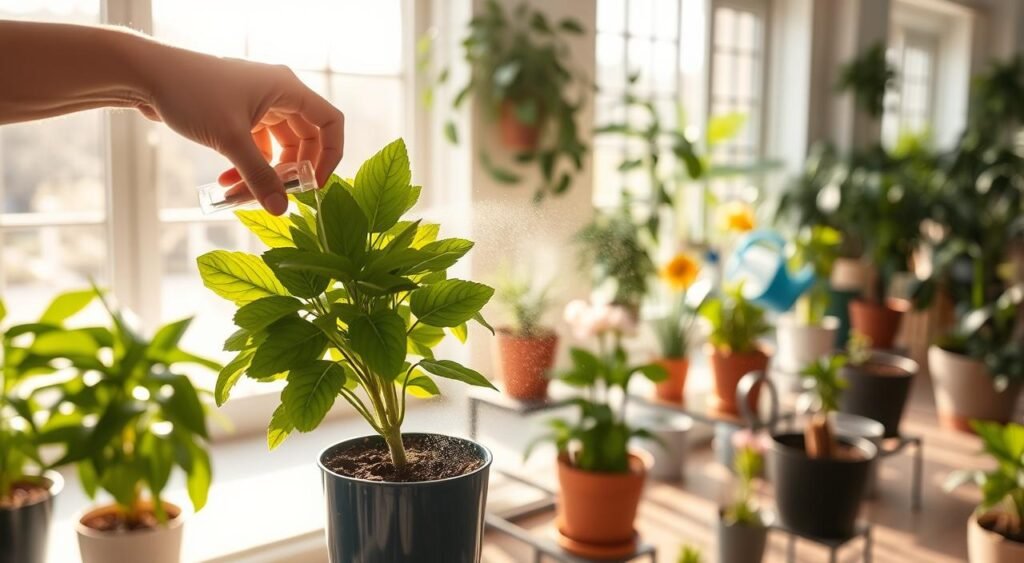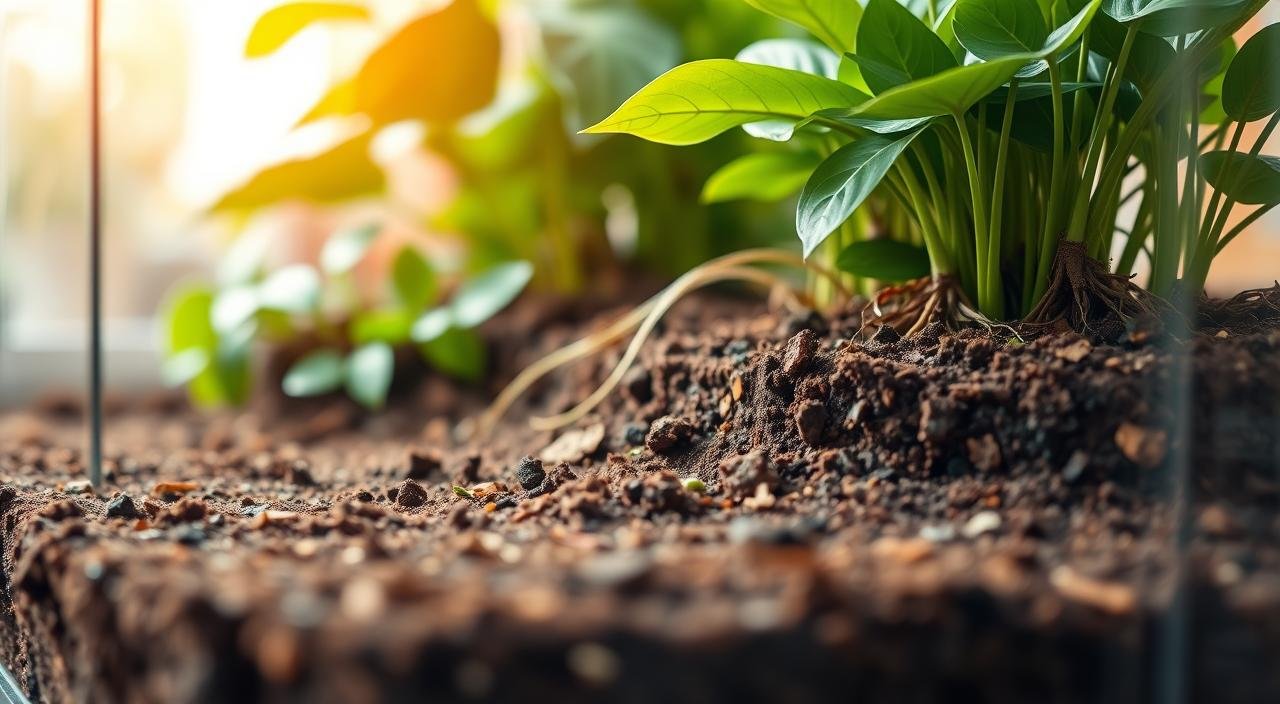Did you know houseplants need at least 16 essential elements to grow, with three—carbon, oxygen, and hydrogen—coming from air and water alone1? This dependency makes soil and fertilization critical for indoor plant care. Unlike outdoor plants, indoor plants can’t access soil nutrients naturally, so proper feeding and soil quality become lifelines for their survival.
Indoor plant care starts with soil that balances nutrients and drainage. Fertilizer labels show three numbers like 10-10-10, which reveal nitrogen, phosphorus, and potassium percentages2. These primary nutrients fuel leaf, flower, and root growth, while secondary elements like calcium and magnesium ensure structural strength. Over-fertilization, however, causes root burns or white salt crusts on pots, stressing plants1.
Key Takeaways
- Indoor plants require 16 elements, with 13 sourced through soil and fertilizers1.
- A balanced fertilizer like 20-20-20 provides equal nitrogen, phosphorus, and potassium2.
- Over-fertilization harms roots by building up salts, blocking water absorption1.
- Soil pH between 5.0-6.5 supports nutrient uptake for most houseplants3.
- Fertilize monthly for most plants, but adjust based on species like monthly for Calathea or biweekly for Pachira2.
Understanding the Importance of Soil for Indoor Plants
Healthy soil is vital for indoor plants to thrive. It anchors roots, delivers nutrients, and manages moisture, ensuring the best indoor plants display their full indoor plant benefits. Proper soil choices protect against issues like root rot and enhance growth potential.
The Role of Soil in Plant Health
The Cornell Mix formula, blending peat moss and perlite, creates drainage and aeration essential for root health4. A pH between 6.0–7.0 ensures nutrients are absorbed efficiently, supportingingsucculents or ferns4. Soil also prevents waterlogging, a common cause of root damage, safeguarding the indoor plant benefits of lush foliage and longevity.
Different Types of Soil for Indoor Plants
- Peat-based mixes: Ideal for general houseplants, combining peat moss with perlite for moisture balance4.
- Succulent blends: Include sand and perlite for drainage, crucial for cacti and jade plants5.
- Aroid mixes: Orchid bark and perlite provide airflow for Monstera and Philodendron roots5.
- Fern mixes: Peat and pine bark retain moisture without waterlogging5.
How to Choose the Right Soil Mix
Match soil to plant needs. Espoma Organic Potting Mix (peat, humus, and perlite) avoids synthetic additives and boosts nutrient retention6. Use 35%–50% more cost-effective potting mixes for vegetables or herbs6. Repot every 1–2 years to refresh nutrients, and avoid over-potting in containers too small or large5. Proper selection ensures the best indoor plants flourish, maximizing their natural indoor plant benefits like vibrant blooms and strong growth.
Essential Nutrients for Indoor Plants

Healthy indoor plant types thrive when their nutrient needs are met. Macronutrients and micronutrients work together to fuel growth,花朵, and resilience. Let’s break down how to meet these requirements.
Macronutrients Explained
Nitrogen (N), phosphorus (P), and potassium (K) are the primary macronutrients. Nitrogen fuels leafy growth, phosphorus boosts flowering, and potassium strengthens stems7. A balanced 16-16-16 NPK mix suits most indoor plants, but ratios like 15-30-15 suit flowering varieties8. Over-fertilizing can harm roots, so follow package guidelines.
Micronutrients and Their Importance
Even in tiny amounts, micronutrients like iron and zinc keep plants thriving. These elements aid photosynthesis and enzyme functions. For example, iron deficiencies turn leaves yellow8.
| Product | N-P-K Ratio |
|---|---|
| Neptune’s Harvest Fish & Seaweed | 2-3-1 |
| Jack’s Classic 20-20-20 | 20-20-20 |
| Grow More Cactus Juice | 1-7-6 |
“Always check soil pH before adding supplements—imbalanced levels block nutrient uptake.”
Choosing the right fertilizer depends on your indoor plant types. Cacti prefer low-nitrogen blends, while flowering plants like higher phosphorus. Adjust fertilization schedules based on growth phases to avoid overfeeding9.
How to Test Soil Quality
Testing soil quality ensures your indoor plants thrive. Start with simple checks to avoid overwatering or nutrient imbalances. These steps help maintain healthy roots and vibrant growth.
DIY Soil Testing Methods
Begin with basic visual and tactile inspections. Check soil moisture by squeezing a handful; crumbly texture means good structure10. Test pH with home kits costing $7–$2511. For a DIY pH test, mix 1 cup soil with distilled water, then add vinegar. Fizzing indicates alkaline soil11.
- Use baking soda to test acidity: no reaction = acidic soil.
- Test at 4–6 inches depth for accurate results11.
- Time tests for fall or spring to plan amendments effectively10.
When to Seek Professional Testing
If plants show persistent yellowing or stunted growth, professional tests reveal hidden issues. Labs analyze nutrient levels and contaminants, often costing $20–50. Collect dry samples (1 pint) in clean containers and send to a local cooperative extension office10. Results take 1–3 weeks and include recommendations for lime or sulfur amendments10.
“Regular testing prevents costly mistakes in soil management,” advises the USDA. Adjustments based on test results boost plant health long-term.
Pair tests with indoor plant ideas like raised beds to customize soil mixes for specific species. For example, acid-loving plants like orchids benefit from peat moss blends10. Monitor pH yearly to adapt to changing conditions.
Watering Techniques for Healthy Soil

Mastering watering is key to indoor plant care. Soil health depends on balancing moisture and drainage, especially in indoor plant pots designed for specific plants. Proper techniques avoid common pitfalls like overwatering, which causes 30% of root rot cases12.
Understanding Water Retention
Water retention varies with soil type and pot design. Clay pots dry faster than plastic, while pots without drainage holes risk waterlogging12. Test soil moisture by inserting a finger two inches deep12. Here’s how to adjust watering:
- Use porous soil for succulents (e.g., cacti) to prevent rot13.
- Leach soil every 4-6 months to flush out salts, using twice the pot’s volume in water13.
- Avoid tap water with fluoride or softeners, which harm 25% of plants12.
Signs of Overwatering or Underwatering
A visual guide to common issues:
| Issue | Signs | Solution |
|---|---|---|
| Overwatering | Mold, soggy soil, yellow leaves13. | Let soil dry; trim rotted roots. |
| Underwatering | Wiltinged leaves, cracked soil13. | Water slowly until drainage occurs. |
“Water soil thoroughly before fertilizing to enhance nutrient absorption,” advises horticulturist Hillman. This step ensures roots access nutrients without burn13.
Adjust based on plant needs: 50% of plants show yellow leaves due to watering errors12. Prioritize pots with drainage holes to reduce damage from excess moisture12.
Fertilizing Indoor Plants: The Basics
“Fertilizers typically contain a ratio of macronutrients represented as N-P-K, with common examples being 10-10-10 or 15-30-1514.
Fertilizers act as vital accessories for indoor plant types, ensuring they receive nutrients lost without natural soil cycles. For example, flowering plants like African violets need higher phosphorous levels, while ferns thrive with balanced blends.
When and How Often to Fertilize
Timing matters. Start fertilizing 8 weeks before the last spring frost—mid-March in regions like Pennsylvania15. Reduce applications to half-strength 8 weeks before fall frost in August15. Slow-release pellets last 3–6 months14, while liquid feeds work bi-weekly in summer15.
Types of Fertilizers for Indoor Plants
Choose based on plant needs and convenience:
| Type | Duration | Application | Best For |
|---|---|---|---|
| Liquid | Bi-weekly/monthly | Water mix | Fast-growing plants |
| Granular | Monthly | Surface sprinkle | Succulents, cacti |
| Slow-Release | 3–6 months | One-time application | Low-maintenance setups |
Liquid formulas like fish emulsion and kelp extracts offer flexibility14, while spikes with bone meal provide steady release14. Always dilute to half strength if unsure to avoid damage14.
Match fertilizer ratios to plant goals: flowering varieties prefer 1-3-1 ratios15, while foliage plants thrive with balanced 5-5-5 blends15. Always consider your indoor plant types’ unique needs before selecting accessories like fertilizers.
Organic vs. Synthetic Fertilizers

Choosing between organic and synthetic fertilizers for indoor plants depends on your priorities. Both options affect plant growth, cost, and environmental impact.
Benefits of Organic Fertilizers
Organic fertilizers, like worm castings or compost, slowly release nutrients over weeks, reducing burn risks16. This gradual process feeds plants steadily while enriching soil structure and microbial activity17. For indoor plant ideas, using homemade compost or fish emulsion aligns with eco-friendly gardening. Organic options cost $50-$95 per application but avoid synthetic salt buildup18.
- Low burn risk due to slow nutrient release16
- Enhances soil biology and water retention17
- Biodegradable and sustainable17
Considerations for Synthetic Options
Synthetic fertilizers deliver immediate nutrient spikes, boosting growth in days16. They cost $25-$80 per application and offer precise nutrient formulations18. However, overuse can lead to soil salt buildup and microbial harm16. Excess nitrogen may cause algal blooms in waterways17.
- Fast-acting results for quick fixes16
- Risk of nutrient runoff and soil depletion16
- Lower upfront cost but may require frequent reapplication18
| Aspect | Organic | Synthetic |
|---|---|---|
| Release Speed | Slow, over months16 | Instant availability16 |
| Cost | $50–$95/application18 | $25–$80/application18 |
| Environmental Impact | Minimal pollution risk1617 | High runoff and toxicity risk1617 |
Both options work for indoor plants when used correctly. Organic choices suit eco-focused growers, while synthetic fits those needing quick fixes. Test soil pH (6.0–7.0) before choosing to ensure plant needs are met18.
Signs Your Indoor Plants Need Fertilization
Proper indoor plant care requires knowing when to adjust nutrients. Healthy plants enhance indoor plant benefits like cleaner air and stress relief.
Two key signs plants need feeding are:
Leaf Discoloration
Color changes often point to nutrient gaps. Common symptoms include:
| Symptom | Possible Deficiency |
|---|---|
| Yellowing leaves (chlorosis) | Nitrogen deficiency19 |
| Purple/red stems | Phosphorus deficiency |
| Brown edges or spots | Potassium deficiency |
Always rule out light or pest issues before adjusting fertilizers19.
Stunted Growth
Slow growth, small leaves, or weak stems signal nutrient shortages20. Under-fertilized plants may also bloom less. Check packaging instructions to avoid overuse20.
- Yellow leaves
- Pale new growth
- Shortened stem sections (stunted internodes)
Addressing deficiencies boosts indoor plant benefits like fuller foliage and vibrant appearance. Always follow dilution rates (¼ or 1/2 strength) to avoid harm19.
Common Mistakes in Soil and Fertilization

Overwateringing is the number one silent killer of houseplants, causing root rot and suffocating roots21.
Over-fertilizing and poor soil choices sabotage even the best indoor plant decoration efforts. Brown roots, crispy leaf edges, and white salt crusts on pot rims are telltale signs of nutrient overdose22. Excess salts block water absorption, causing wiltinged plants despite moist soil. Immediate action includes leaching—flushing soil with copious water—to dilute salt buildup21.
Root damage occurs when fertilizer salts dehydrate tender roots. Signs like yellowing leaves and slowed growth indicate overfeeding. Many gardeners forget fertilizers should only be applied during active growing seasons23. Always follow package instructions and reduce feedings in winter when plants rest.>
Indoor plant care failures often start with improper soil selection. Using outdoor garden soil indoors traps moisture, causing root rot and pest issues. For example, cacti thrive in sandy mixes but suffer in peat-heavy soils23. A 2023 study found 70% of plant owners neglect seasonal soil adjustments, leading to drainage problems22. Always match soil types to plant needs—orchids require bark blends while ferns need moisture-retentive mixes.
Mistakes in soil choice directly impact indoor plant decoration aesthetics. Compacted soil causes leggy growth, while improper drainage ruins foliage vibrancy. Regular soil checks and timely repotting (only when roots outgrow pots) prevent these issues23. Proper soil ensures plants remain healthy and visually appealing in any room.
Tips for Maintaining Healthy Indoor Plant Soil
Maintaining soil health ensures indoor plants thrive long-term. Start by aerating soil monthly to prevent compaction. Use a wooden stick or specialized indoor plant accessories like handheld aerators to loosen the top layer. Proper airflow supports root health and microbial activity, reducing risks of root rot linked to overwatering24. Always pair aeration with well-draining indoor plant pots to avoid waterlogging.
Regular Soil Aeration
Gently poke the soil surface every 4–6 weeks to break up dense layers. For deeper care, repot plants annually using mixes with perlite or pumice. Tools like moisture meters (a key indoor plant accessory) help track soil conditions, ensuring roots get oxygen without excess moisture. Choose pots with drainage holes to balance water retention and airflow, addressing the 40–60% humidity preference of most species25.
Mulching for Moisture Retention
Apply mulch like decorative stones or sphagnum moss to lock in moisture. Opt for porous indoor plant pots that match your plant’s needs—clay pots dry faster for cacti, while plastic retains moisture for ferns. Mulch also regulates temperature fluctuations, protecting roots in 60–75°F environments25. Reapply mulch every 3–6 months as it breaks down.
Pair these practices with seasonal fertilization schedules and pest checks. Healthy soil forms the foundation of vibrant growth, so prioritize soil quality over frequent repotting. By combining aeration, mulching, and proper containers, your plants build resilience against common issues like root rot24. Regular care turns routine tasks into lasting solutions for lush indoor greenery.
FAQ
Why is soil quality important for indoor plants?
What are the best indoor plants for beginners?
How can I tell which type of soil is best for my indoor plants?
What are macronutrients and why do my indoor plants need them?
What DIY methods can I use to test my soil quality at home?
How often should I water my indoor plants?
What types of fertilizers are best for indoor plants?
What are the benefits of using organic fertilizers for indoor plants?
How can I identify if my plants need fertilization?
What are some common mistakes to avoid in soil and fertilization?
What are some tips for maintaining healthy indoor plant soil?
Source Links
- Houseplant Fertilization | Home and Garden Education Center – https://homegarden.cahnr.uconn.edu/factsheets/houseplant-fertilization/
- Fertilizing Houseplants 101 — HOMESTEAD BROOKLYN – https://homesteadbrooklyn.com/all/2017/5/3/fertilizing-houseplants-101
- Growing Indoor Plants with Success – https://extension.uga.edu/publications/detail.html?number=B1318&title=growing-indoor-plants-with-success
- Houseplant 101: The Indoor Gardener’s Guide to Soil – https://jomostudio.com/blogs/plant-with-jomo/houseplant-101-the-indoor-gardeners-guide-to-soil?srsltid=AfmBOorVprtie1QGPqKDwQ50g9CKgT8zPFMy_a_GkPtnYHZHszD2If1i
- The Science of Soil: Creating an Environment for Growth – https://www.plantvine.com/2023/10/24/the-science-of-soil-creating-an-environment-for-growth/?srsltid=AfmBOooY00ElHZZgoFLORJlfrzGLFRndpdLWhpG10c5h7tV4LHYWMlxH
- Why Use Potting Soil for Your Indoor Plants – https://deckers-nursery.com/garden-learning-center/use-potting-soil-for-indoor-plants/
- How to Fertilize Indoor Plants: Ways to Feed Houseplants – https://www.joyusgarden.com/fertilizing-indoor-plants/
- All About Houseplant Fertilizer | Plant Care Tips – https://www.thesill.com/blogs/care-miscellaneous/plant-care-fertilizer?srsltid=AfmBOopLqfJKjmzpz2et1D7Lotul14As9Wb8d_GdxfPNUKm42ZrM02Nl
- The Best Fertilizers for Indoor Plants, Tested and Reviewed – https://www.bobvila.com/articles/best-fertilizer-for-indoor-plants/
- How to Use a Soil Test Kit | Lowe’s – https://www.lowes.com/n/how-to/test-and-improve-your-soil
- How to Test Soil pH With and Without a Kit – https://www.thespruce.com/how-to-test-soil-acidity-alkalinity-without-a-test-kit-1388584
- How to Water Indoor Plants – https://www.missouribotanicalgarden.org/gardens-gardening/your-garden/help-for-the-home-gardener/advice-tips-resources/visual-guides/how-to-water-indoor-plants
- Watering Indoor Plants | University of Maryland Extension – https://extension.umd.edu/resource/watering-indoor-plants
- All About Houseplant Fertilizer | Plant Care Tips – https://www.thesill.com/blogs/care-miscellaneous/plant-care-fertilizer?srsltid=AfmBOorlGS9NccQsjEok_zjt_xjPqe0GzpFXXsesHF6UqwgO-AG5tbhQ
- Houseplant Fertilizer Basics: How and When to Feed Houseplants – https://savvygardening.com/houseplant-fertilizer/
- Organic Vs. Synthetic Fertilizer: Pros, Cons, And Which To Use – https://eos.com/blog/organic-vs-synthetic-fertilizers/
- Organic vs Synthetic Fertilisers in Indoor Gardening: Pros and Cons – https://acornhorticulture.com/organic-vs-synthetic-fertilisers-in-indoor-gardening-pros-and-cons/
- Organic vs Synthetic Fertilizer – Pros, Cons, Comparisons and Costs | Fixr – https://www.fixr.com/comparisons/organic-vs-synthetic-fertilizer
- Wild Interiors — When and How to Fertilize My Houseplants? – https://www.wildinteriors.com/blog/how-to-fertilize-indoor-plants
- Fertilizer Is the Key to Healthy, Strong Houseplants—Here’s When (and How) to Apply It – https://www.marthastewart.com/when-to-fertilize-houseplants-8599360
- 6 Common Mistakes When Caring for Houseplants and Tips to Avoid – https://succulentsbox.com/blogs/blog/6-common-mistakes-when-caring-for-houseplants-and-tips-to-avoid?srsltid=AfmBOopvJmA6ytgh_iieVsoUFq-jjri0XT7jRQEdq5bKYcbRoR3gxFfn
- 10 Most Common Houseplant Mistakes – https://jomostudio.com/blogs/plant-with-jomo/10-most-common-houseplant-mistakes?srsltid=AfmBOoogI836_kkxCwKG9BEVHWwjMF4QQHdo9fKsWfLkkA7u9LEa13mN
- 6 Common Indoor Plant Care Mistakes – Bloomscape – https://bloomscape.com/plant-care/common-indoor-plant-care-mistakes/?srsltid=AfmBOoo9fKG4v1oMloH_ZDsbarZQlkJ6dUjBpMpFMrh1oL7PZYPmWZnt
- 10 Tips to Ensure Happy, Healthy Houseplants – https://www.bhg.com/gardening/houseplants/care/houseplant-care-guide/
- Indoor Plant Care: Your Guide to Growing Healthy Houseplants – https://www.provenwinners.com/learn/houseplants/care


В работе часто применяются базы для xrumer, которые помогают автоматизировать размещение ссылок.
Спасибо за ваш комментарий